| EUROPEAN INTEREST IN RAS AL KHAIMAH | ||||
|---|---|---|---|---|
| The Portuguese Era | The Dutch Era | The British Era | ||
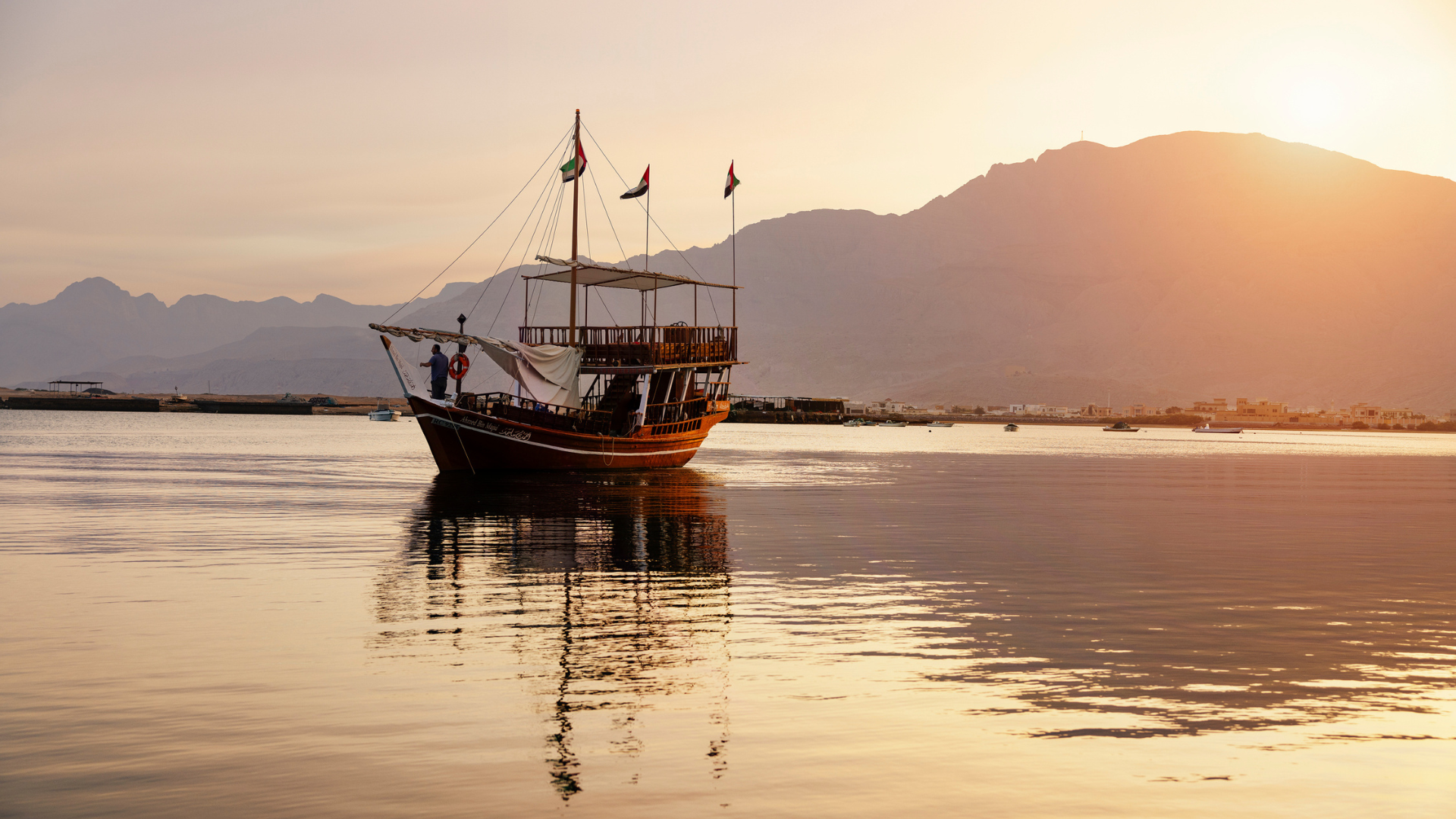
During the Islamic Golden Age, Muslim traders dominated commerce by land and sea – especially in the Indian Ocean, the Red Sea and the Mediterranean. However, this changed with the decline of the great Islamic empires and the arrival of the Portuguese. The Portuguese presence also caused a reduction in business for Arab merchants, with them fighting for hegemony over commerce in the area. They especially wanted to control the spice trade, which was, for centuries, dominated by prominent Arab mariners who came from the coastal Emirates and Oman.
The Portuguese reached the height of power by 1560, however, their hold on Arabia gradually started reducing by the seventeenth century, mainly due to the ongoing indigenous resistance. Numerous uprisings had taken place along the Arabian peninsula, of which the major revolts took place in 1521, 1526, 1602 and 1622. The 1622 rebellion is of particular significance as it marked the symbolic defeat of the Portuguese Empire, as an Anglo-Persian coalition recaptured Hormuz from the Portuguese. A few years later, the Ya’arabi dynasty from Oman succeeded in ousting them from Julfar and Dibba in 1633; from Sohar in 1643; and from Muscat in 1650.
THE PORTUGUESE ERA
At the turn of the sixteenth century, Ras Al Khaimah was as important to south-east Arabia’s mercantile affairs as it had been for centuries. It continued to be a major hub for maritime trade, remained strategically and logistically important, and had increased in both influence and wealth. Writing in the opening years of the century, the Italian traveller Ludovico Varthema described Julfar as “abounding in everything” and spoke highly of its “good seaport”. Varthema would have seen merchants from Hormuz, India and other locales and revelled in the cosmopolitan nature of a medieval jewel.
For the first few years of the new century Ras Al Khaimah remained under the influence of the Kingdom of Hormuz, which suffered from a period of internal turmoil from 1498 to 1505. Yet, despite intense rivalry for the throne, few would have imagined that within the space of a few years the balance of regional power would shift dramatically, opening up a whole new chapter of Ras Al Khaimah’s history. When the Portuguese under the command of Afonso de Albuquerque attacked Hormuz in 1507, it heralded the beginning of European dominance in the Arabian Gulf. The Portuguese were the first European proponents of seaborne violence and protectionism to enter the Arabs’ sphere of maritime influence, and their arrival would upend centuries of free-flowing trade.
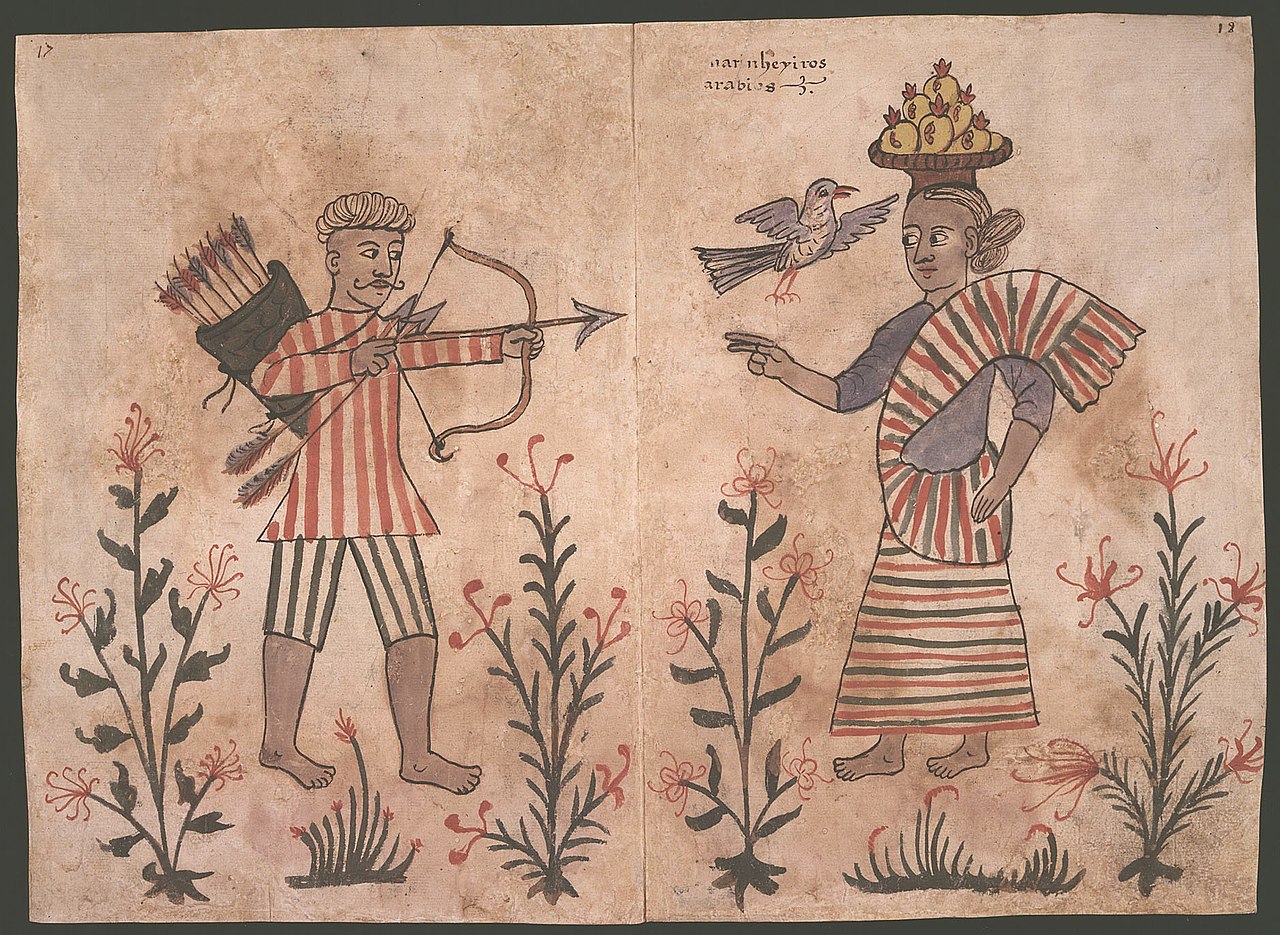
An illustration of Arabian sailors from the Códice Casanatense, a set of sixteenth-century Portuguese illustrations that depict peoples and cultures whom the Portuguese frequently had contact with around the Indian and Pacific oceans.
For more than 100 years, the Portuguese would enforce their monopoly on commerce, inverting the balance of power and hastening the decline of Arab interests. The Portuguese turned both the Indian Ocean and the Arabian Gulf into militarised zones, breaking centuries of peaceful trade between the Arab world and the Indian subcontinent. Mariners from Julfar and the Batinah coast, who for years had enjoyed the riches that were to be gained from the uninterrupted and unimpeded exchange of goods, suddenly found themselves at the mercy of an imported foreign power. A power that had no qualms about using extreme violence to enforce its own brand of international trade.
The repercussions for Ras Al Khaimah would be significant. Although the Portuguese wouldn’t fully subdue the Kingdom of Hormuz until 1515, the fall of Hormuz meant that all the cities and ports on the Arabian Gulf now paid tribute to Portugal. The Portuguese were primarily tax collectors, and from the customs house at Hormuz they oversaw the lucrative trade that ran through the Strait of Hormuz. They established a licensing system known as the ‘cartaz’, which enforced their monopoly over trade and enabled them to collect funds through taxation. Ports also had to pay tributes to Portugal via Hormuz, which was little more than a vassal state following its defeat. Amongst those ports was Julfar, although by the time the Portuguese arrived it was in the process of being abandoned in favour of Ras Al Khaimah. A Venetian map from the sixteenth century mentions Ras Al Khaimah but not Julfar, and it is probable that by that time Julfar had morphed into a geographical term.
The Portuguese valued Ras Al Khaimah for exactly the same reasons as all the previous empires and kingdoms. It was strategically located, provided access to fertile palm gardens, and was a major hub for trade in everything from pepper to pearls. It was a supplier of goods and logistical support to the island of Hormuz and was valued for its seafaring tradition and wealth. According to a summary of the income of the king of Hormuz in 1515 by the Portuguese chronicler João de Barros, the revenues from Julfar amounted to 3,000 pardaus (units of currency), surpassing all but one other port in the kingdom, with which it was equal.
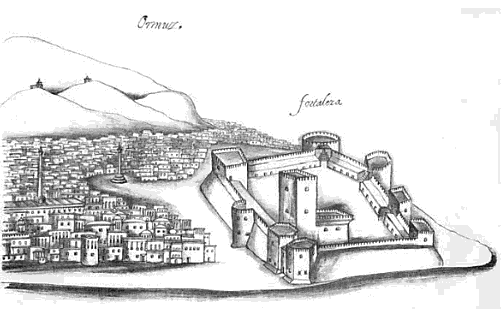
The city and fortress of Hormuz in the sixteenth century, as depicted by Gaspar Correia in Lendas da Índia.
And yet evidence of direct Portuguese involvement in Ras Al Khaimah is limited, despite an atlas by the cartographer Lazaro Luis recording a series of Portuguese fortresses along the coast of the Oman Peninsula, including one at Julfar, in 1563. No archaeological remains of this fortress or of any others have yet been discovered, despite numerous references to them in both maps and official correspondence. One thing the Portuguese did leave behind, however, was a considerable amount of documentation, including personal and official letters and the memoirs of various Portuguese officials. Some provide insight into the importance of the port at that time, while others indicate the almost constant state of warfare that prevailed. In 1525, a letter to the governor of India noted that Ras Al Khaimah was a wealthy port equivalent to Bahrain, while a record of events in 1521 refers to the selling of pepper. A letter from Rafael Lobo to João de Castro, the viceroy of Portuguese India, dated 1546, noted that several vessels preferred to port at Ras Al Khaimah without paying any tribute to the Portuguese crown. The same year, a letter from Sebastião Lopes Lobato to de Castro refers to an attack by the Bedouin of the Banu Jabr and the plundering of the port. Previous correspondence between de Castro and the vizier of Hormuz had mentioned the construction of a Banu Jabr fortress at Sohar, with the forces of Ras Al Khaimah and Bahrain sent to destroy that fortress under the leadership of the vizier of Ras Al Khaimah, Ra’is Shehab al-Din.
The Portuguese rarely intervened in the affairs of the Lower Gulf, leaving the day-to-day running and overseeing of the ports of south-east Arabia to Hormuz. Only when open rebellion broke out, such as in 1521, did they become actively involved. That revolt began in Bahrain, before spreading to Sohar in 1523 and Muscat and Qalhat in 1526. At some stage violence also erupted in Ras Al Khaimah, with a large number of Portuguese traders killed in the town. The largest number of merchants killed outside of Hormuz was in Julfar, indicating the importance that Portuguese traders placed in Ras Al Khaimah.
It was not until the capture of Hormuz by English and Persian forces in 1622 and the loss of other important towns that the Portuguese became directly involved in Ras Al Khaimah. Forced from their island base in the Arabian Gulf, the Portuguese turned their attention to the Oman Peninsula, making Muscat their base and attacking and occupying ports along the coast. According to an account of the feats of Admiral Ruy Freire da Andrada, two vessels commanded by Filipe da Fonseca and Gaspar Pereira set sail for Ras Al Khaimah in either 1621 or 1622 following reports of open rebellion in both Ras Al Khaimah and Rams. The following battle to retake the town involved ferocious fighting, with the local population using the mosque as a makeshift fortress. Sohar was later retaken by the Portuguese, followed by Dibba and Khor Fakkan in 1623.
It is during this period of revolt against Portuguese rule that the first ever recorded mention of the Qawasim originates. According to Portuguese sources, the fort at Kalba was captured by a leader known as ‘Casmi’ (Al Qasimi) and, although the fort was later recaptured, the reference suggests the Qawasim were already well established at that time. The ruling family is mentioned again in 1650, this time as part of a peace treaty between the Portuguese and the Omanis (see section on the Qawasim), although their exact identity is uncertain. What is certain is that the Qawasim are among only a handful of prominent personalities frequently mentioned by the Portuguese.
The Portuguese presence in Ras Al Khaimah lasted little more than eleven years, although manuscripts dating to 1629 refer to the construction of a fortress by Andrada. Ultimately, the emergence of Nasir bin Murshid, the first Imam of the Ya’arabi dynasty of Oman, spelt the end of the Portuguese occupation. The Imam successfully united the warring tribes of Oman, leading to an attack on Ras Al Khaimah and Rams in 1633 and the successful capture of both towns. According to Portuguese sources, Ras Al Khaimah was raised to the ground, leading to retaliatory Portuguese attacks along the eastern seaboard, including Seeb in modern-day Oman.
The loss of Hormuz may have marked the end of Portuguese supremacy in the Gulf, but it was the concerted attacks of the Ya’arabi and their harrying of Portuguese interests all the way to the coast of East Africa that led to the collapse of Portuguese power and influence. Sohar was captured by the Ya’arabi in 1643 and Muscat in 1650, and although the Portuguese would continue to pursue their interests in the region until the early eighteenth century, the arrival of Dutch and English naval forces turned the screw on the Portuguese and led to the emergence of new powers in the region.
THE DUTCH ERA
When a combined Dutch and English fleet engaged with the Portuguese in the Strait of Hormuz in 1625, the balance of power in the Arabian Gulf shifted once again. Although the battle was inconclusive, the Portuguese era of naval dominance was effectively over. From that moment on, the Dutch East India Company and the English East India Company – both joint stock companies – would compete for influence in the Arabian Gulf, leading to conflict between the two nations and the eventual emergence of the Dutch as masters of the sea.
The Dutch had not come to the Arabian Gulf to gain territory, they had come to trade. Much like the Portuguese, they relied on force – or the threat of it – to procure lucrative trade agreements with various rulers, most notably the Safavid dynasty in Iran. They issued naval trade licenses, taxed passing vessels, and controlled commercial assets coming in and out of the Arabian Gulf. All of which would have put them in contact with the rulers of Ras Al Khaimah.
Although it is impossible to say with any certainty who those rulers were in the early years of Dutch dominance, the power and influence of the Qawasim gradually increased. At some stage their power base spread from the eastern coast of what is now the UAE to Ras Al Khaimah. The emirate’s earliest known leader, Sheikh Rahma bin Matar Al Qasimi, was described by the Dutch as the ‘Emir of Julfar’ and as one of the richest and most influential of Arab merchants in the first half of the eighteenth century. Nadir Shah, the powerful ruler of Persia, also recognised Al Qasimi as the hereditary ruler of Julfar in 1740, leading to his claiming of independence following Shah’s death in 1747.

A Dutch map of the Arabian peninsula from 1707. © Qatar National Library
It is entirely plausible that not a single Dutchman set foot in Ras Al Khaimah during the early years of their ascendency, despite the Dutch East India Company’s monopoly on trade. There is certainly no physical evidence of a Dutch presence in the emirate, nor is there any mention of hostilities between the two. As with the Portuguese, however, they bequeathed a large body of correspondence, with the first mention of Julfar appearing in a Dutch document dated 1634. In it the Dutch offer assistance to the local population in their fight against the Portuguese. It is the first of many documents that refer to pearling, the emergence of the Qawasim, and the landscape and peoples of the Oman Peninsula.
Some of the earliest known Dutch encounters with the region are provided by Hendrick van Wijck, director of the Dutch East India Company in Bandar Abbas. He wrote of enquiring whether it would be possible to acquire pearls from Sohar or Julfar and later sent two junior merchants, Jacob Vogel and Adriaen vander Werff, on an expedition to Muscat in 1666. The voyage is notable for its historically valuable description of the coastline of the Musandam Peninsula, with the merchants visiting Kassab, Dibba, Khor Fakkan and Kalba.
Like the Portuguese, the Dutch showed an interest in pearling. In 1664, a report from the Dutch governor in Batavia (modern-day Jakarta in Indonesia) to the directors of the Dutch East India Company made reference to the pearl trade in Julfar. “It is decided that our representatives wish to expand their trade, but they have to send two traders who are clever and own expertise, prior to the pearling season in Bahrain or Julfar, where pearling is performed,” said the report. “They should issue their order to remain therein until the end of the pearling season, to oversight, in person, the pearls trade therein.” Whether this was followed up on is unknown, but it is clear that Dutch interaction with Ras Al Khaimah was limited.
The primary source of information relating to the emirate is Baron Tiddo Frederik van Kniphausen, the Dutch East India Company’s agent on the island of Kharg. The Dutch had established a factory on Kharg in 1753 and Kniphausen would use it as a base to travel extensively across the region, visiting Bahrain and Kuwait and heading south towards Ras Al Khaimah in 1756. He described the town as having 400 well-armed men and around sixty large vessels that were capable of travelling as far as Mocha in Yemen. It was, he wrote, a “considerable town, fortified in local style, provided with some ordnance, and which is inhabited by the tribe of Huwala called Quassum”. He also noted that several expeditions against the Qawasim by the Imam of Muscat had been unsuccessful, with their leader, Sheikh Rahma bin Matar Al Qasimi, supported by “several tribes of Bedu or Arabs from the desert”. Kniphausen also provides the earliest known description of the coastal town of Jazirat al-Hamra, which he described as being inhabited by the Za’ab tribe and engaged in pearling.

The remains of the village at Jazeera Al Hamra in Ras Al Khaimah. © RAKTDA
By the time of Kniphausen’s visit, however, the Dutch were already in decline. By the 1750s they had lost most of their holdings in the Indian Ocean and their factories at Bandar Abbas, Bushehr and Basra were eventually closed due to increased competition from the British. The Dutch continued to operate from Kharg until 1766, when Arab resistance, led by Mir Muhanna, resulted in Dutch defeat and the liberation of the island. The Qawasim, in contrast, were very much in the ascendency.
THE BRITISH ERA
By the time the British began to take an interest in the affairs of Ras Al Khaimah, the Qawasim not only ruled Ras Al Khaimah, but Sharjah and parts of the Persian coastline, too, including the port town of Lingah and Laft on the island of Qeshm. It was Ras Al Khaimah, however, that formed the centre of Qawasim power, and from 1777 was ruled by Sheikh Saqr bin Rashid Al Qasimi.
The Qawasim’s possessions on both sides of the Strait of Hormuz meant they commanded an enormously strategic position, enabling them to play an important role in the region’s affairs and to challenge Oman for control of the sea. They had amassed a powerful fleet, had access to thousands of men, and were in an almost constant state of conflict with their southern rival. Other Qawasim towns or allies included Jazirat al-Hamra, Rams and Hamriyah in modern-day Sharjah, and at the height of their power they could call upon thousands of warriors.
Such strength and influence would bring them into conflict with Britain, which wished to secure access to the Arabian Gulf for its trade and viewed the activities of the Qawasim, which included the levying of tolls and acts of alleged piracy, with growing concern from the late eighteenth century onwards. Up until that point the British, who had opened their first trading post in the Arabian Gulf in 1616, appear to have had little interest in south-east Arabia beyond Muscat. They showed even less interest in the pearl trade, despite its attraction to previous European powers and its importance to the region’s coastal communities.
As the British East India Company’s records are the only detailed contemporary account of the events that followed, the historical picture, unfortunately, is incomplete. Accusations of piracy by the Qawasim have been disputed by a number of writers and historians and the dearth of local contemporary sources only acts to compound the issue. Many contemporary British accounts also include phrases and terminology that can only be described as derogatory. John Gordon Lorimer, a British diplomat and author of Gazetteer of the Persian Gulf, Oman and Central Arabia, is particularly bad in this respect, referring to “ruffians who depended on piracy for their livelihood” and “scoured the seas plundering all indiscriminately”. Nevertheless, the British considered the Qawasim pirates and their response to numerous raids on British shipping would have far-reaching consequences, not only for the people of Ras Al Khaimah, but for the entirety of what would become the United Arab Emirates.
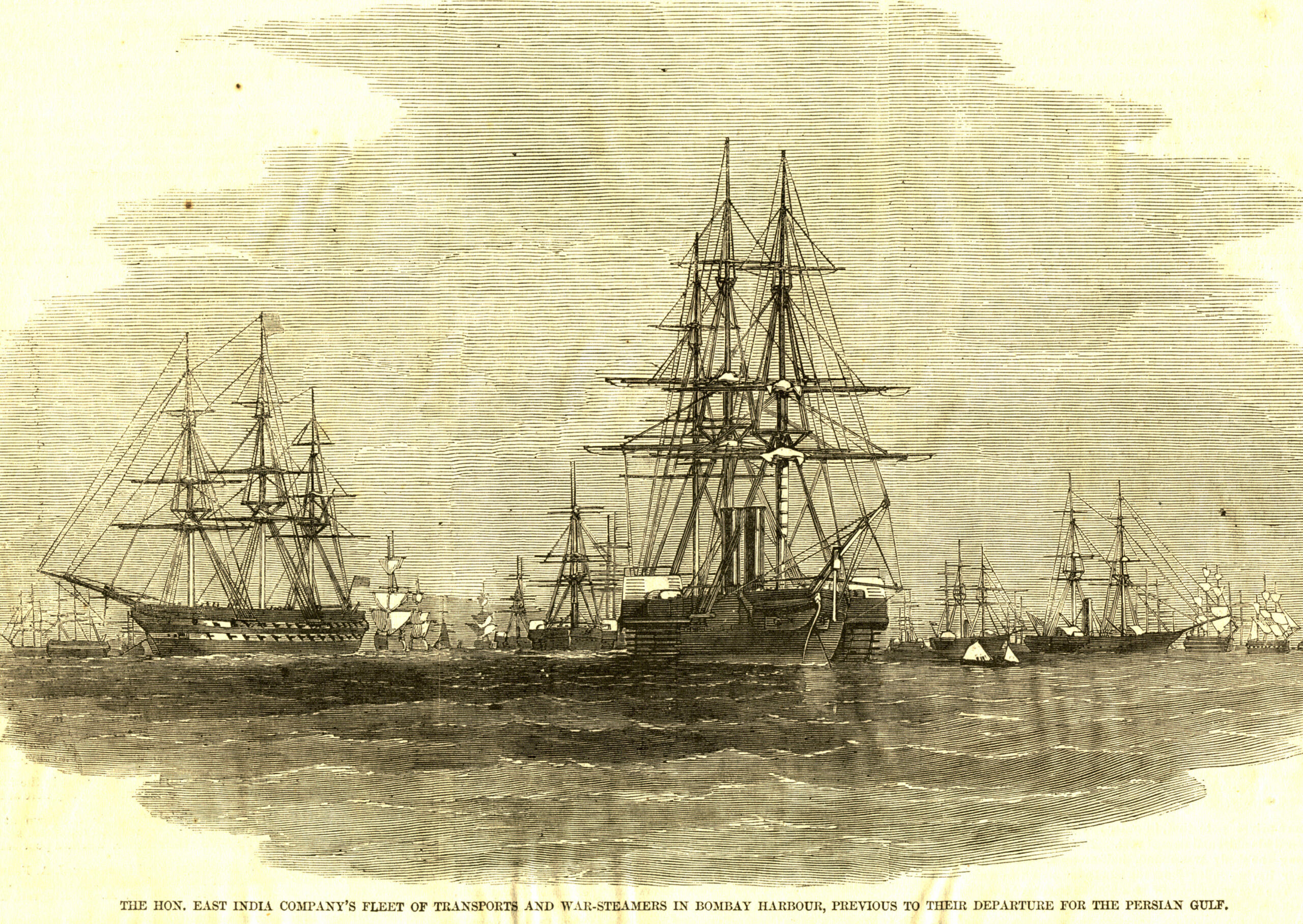
An illustration of the British East India Company fleet.
The origins of British concern can be traced back to 1797, when two vessels, the Bassein and the Viper, were either boarded or attacked. The Bassein was taken off Rams by a fleet of dhows belonging to the Qawasim and later released. In response to the boarding of the Bassein, Al Qasimi wrote to the British resident in Basra, Samuel Manesty, saying: “In respect to your vessel which some little time ago fell in with my vessels cruising on the Persian shore of the Gulf, and which you suspect them of wishing to capture, let me declare conscientiously ‘God forbid I should think of capturing your vessels’.” The Viper, which was caught up in hostilities between the Qawasim and the Omanis, engaged with a number of dhows off Bushehr in September of the same year. Once again, Al Qasimi wrote to Manesty, stating: “We have not any dispute with the English, they are our friends; our enemies are the people of Oman. As we have absolutely informed you, we are as friendly in our disposition towards you as you can wish. We will not injure you nor are we willing that others should do so. We will do you every good that may be in our power, but not the least harm.”
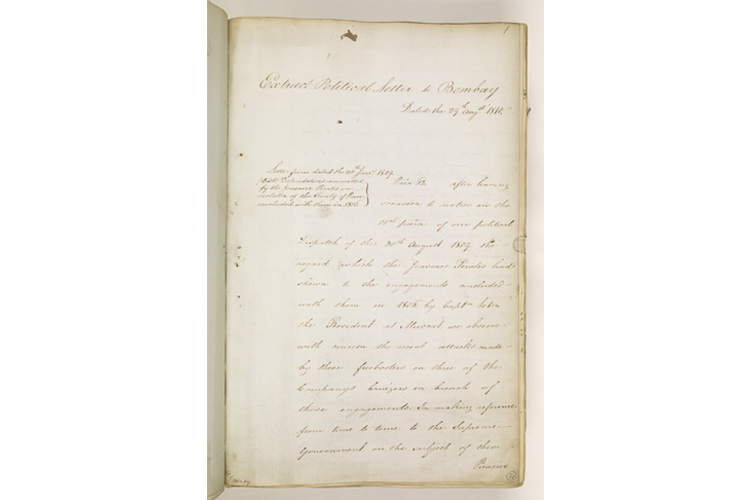
An extract from Political Consultations and Political Letters sent to and from the British Government in Bombay, relating to the “attacks on merchant ships by the Joasamee [Al Qasimi]”. © Qatar National Library.
It wasn’t until 1804 that the first direct accusations of piracy were made against the Qawasim. Two British ships, the Trimmer and the Shannon, were attacked by Sheikh Qadhib al Qasimi, the ruler of Lingeh, in December of that year, followed by two confrontations with a number of Qawasim vessels in 1805. The British responded by signing a peace treaty between themselves and the Qawasim (led by Sheikh Sultan bin Saqr Al Qasimi) in 1806. Despite the agreement, attacks on British shipping continued and gradually increased in severity. In October 1808, an eight-gun British schooner called the Sylph was attacked by two large dhows, resulting in the death of thirty members of the crew. The following May, the Minerva was captured following a two-day pursuit and taken to Ras Al Khaimah. Most of its crew were either killed or held as captives before being released. Both incidents helped to stoke anti-Qawasim sentiment.
The British response would be a military assault on Ras Al Khaimah, despite a limited force being available in the Gulf at the time. An expeditionary force gathered at Bombay during the summer and set sail for Muscat on 17 September 1809. Consisting of Royal Navy and East India Company vessels commanded by Captain John Wainwright, the force reached Ras Al Khaimah on 11 November and commenced an attack the following day. The bombardment was initially ineffective but many of the town’s defences were damaged or destroyed and an unknown number of fighters and civilians killed. When the bombardment ceased, the inhabitants (probably led by Sheikh Husain bin Ali of Rams) called a hurried majlis, during which it was decided to defend the town and to evacuate as many women and children as possible.
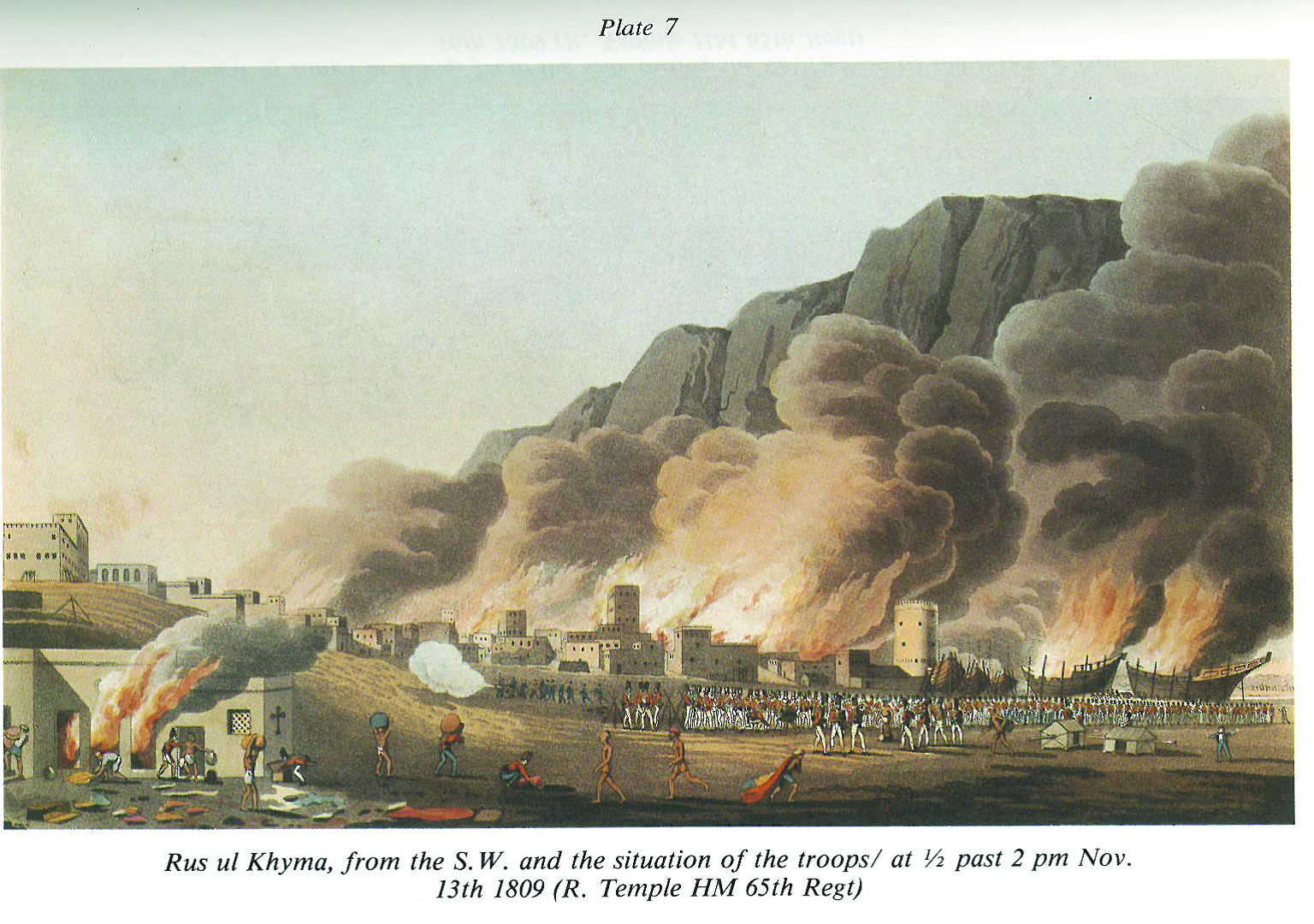
A lithograph showing the British attack on Ras Al Khaimah in 1809.
In the early hours of the following day the British launched an amphibious assault, landing a diversionary force to the north of the port’s defensive positions and a main attacking body to the south. By mid-morning the larger force had reached the town, where intense house-to-house fighting took place over the course of the next three hours. The advancing troops set fire to many of the town’s buildings, flushing out the port’s defenders and eventually storming the ruler’s palace. At some stage during the fighting a significant counterattack was launched by the defenders, but by two o’clock in the afternoon, the centre of the town had been taken.
Exact casualty figures are unknown but up to 100 men from Ras Al Khaimah had been killed during the attack and many more the previous day. By four in the evening, the British had set fire to an estimated fifty vessels moored in the creek and used explosives to flatten any of the port’s remaining fortifications, although the town’s northern quarters remained in Qawasim hands. The fighting had lasted for two days but, according to Lorimer, “no admission of defeat had been obtained from the enemy, who immediately re-occupied the shore with every gesture of defiance” following the British withdrawal. Three days later, twenty Qawasim ships were destroyed in the port of Lingah, while Laft was attacked on 26 November. Fierce resistance was encountered at the latter, with further search and destroy missions continuing into January 1810.
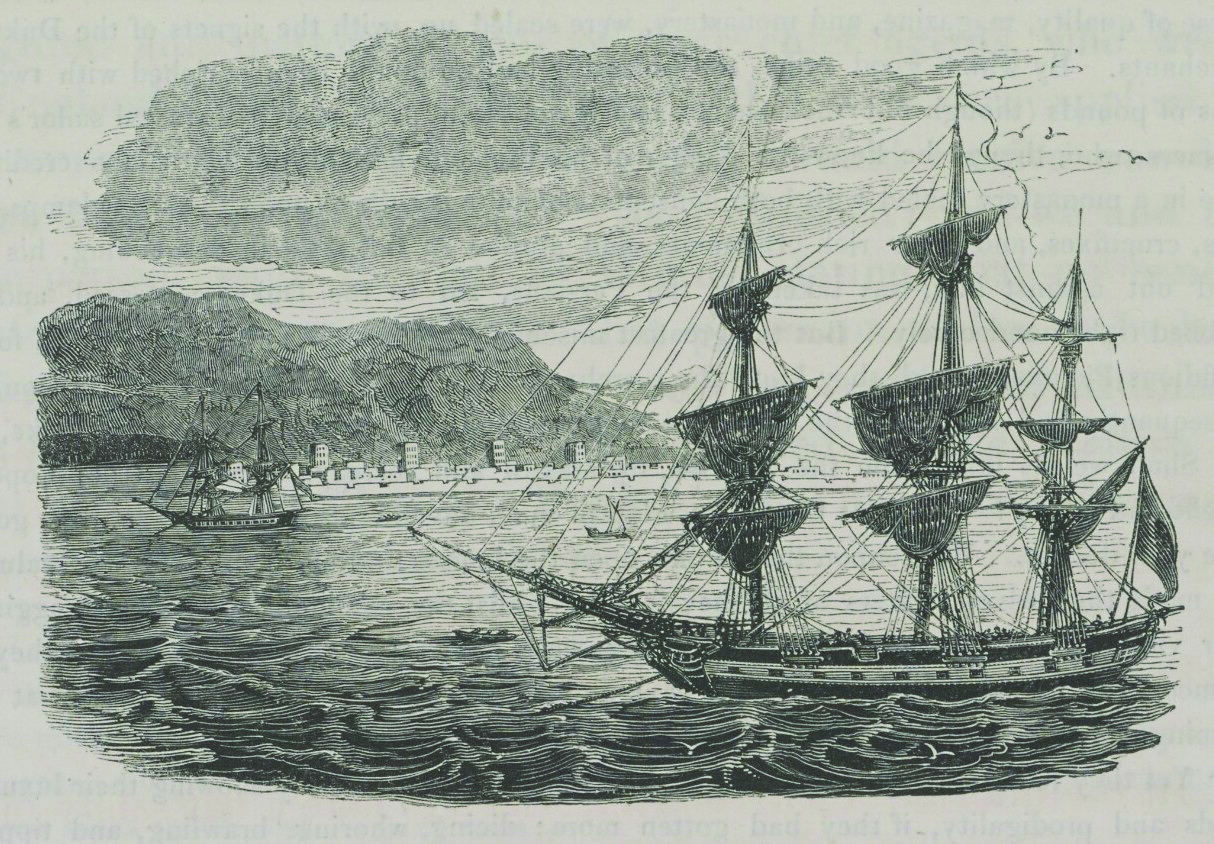
A lithograph showing the British attack on Ras Al Khaimah in 1809.
If the British thought that was the end of the Qawasim, they were mistaken. Although there was a brief lull in hostilities, Ras Al Khaimah was rebuilt and by 1815 the Qawasim were once again trading blows with the British. This time the focus of attention was India, where three Indian merchant vessels from Surat (carrying British passes and colours) were captured in December 1816. Allegations of piracy against the Qawasim intensified, leading to appeals from Indian merchants for assistance. That assistance initially arrived in the form of an ineffective naval assault in November 1816. Under the command of Captain Bridges, the eighteen-gun HMS Challenger, supported by the cruisers Mercury and Vestal, appeared off the coast of Ras Al Khaimah on 27 November.
Onboard the Challenger was the British author and traveller James Silk Buckingham, who later wrote extensively of his travels. Accompanying Bridges ashore during negotiations with Sheikh Hassan bin Rahma Al Qasimi, he provided one of the earliest known descriptions of a leader of the Qawasim. Noting that Al Qasimi was about 40 years old, he wrote: “One of his eyes had been wounded, but his other features were good, and his teeth beautifully white and regular, his complexion very dark, and his beard scanty, and chiefly confined to his chin. He was dressed in the usual Arab garments, with a cashmere shawl turban, and a scarlet benish, of the Persian form, to distinguish him from his followers.”
Buckingham also provided a description of the town itself, which he said was “probably half a mile in length, from north-east to south-west, and a quarter of a mile in breadth, from the beach of the sea to the beach of the creek. There appeared to be no continual wall of defence around it, though round towers and portions of walls are seen in several parts, probably connected in line, but not yet repaired since their destruction. The strongest points of defence appear to be a fortress at the north-east angle, and a double round tower, near the centre of the town; in each of which, guns are mounted, but all the other towers appear to afford only shelter for musketeers. The rest of the town is composed of ordinary buildings of un-hewn stone, and huts of rushes and long grass, with narrow avenues winding between them.”
Buckingham guessed the number of inhabitants to be at least 10,000, of which around 3,000 were men able to bear arms. Al Qasimi’s relative, Ameer Ibrahim, was the commander of the maritime force, but the Qawasim refused to capitulate and the British bombarded the town before eventually withdrawing. Nearly every shot had fallen short.
The situation became progressively worse in the following years, until the British finally ordered a military assault on Ras Al Khaimah in December 1819. Larger and more organised than anything previously sent against the town, the expedition would lead to the Qawasim’s defeat, the capture of their fleet, and the occupation of Ras Al Khaimah.
The British force, which included HMS Liverpool, HMS Eden and HMS Curlew, as well as over 3,000 soldiers, was led by Major General William Keir Grant and set off from Bombay on 3 November 1819. The full force was assembled off Ras Al Khaimah by the morning of 2 December, although the offensive didn’t begin until early the following day, when soldiers of the 47th and 65th Regiments of Foot landed about two miles south of the town. The soldiers brought stores and equipment ashore, including two howitzers and two six-pounder guns, and dug in. The Qawasim had prepared their defences well. A stone fort had been built following the British attack of 1809 and a new wall had been constructed closer to the town, in front of which had been dug rifle pits. The assault began on the morning of 4 December, with much of the day spent in bloody close-quarter combat as the British fought their way towards the outskirts of the town. The Qawasim fought bravely and tenaciously, killing a major of the 47th Regiment of Foot, but by dusk the British were within 400 metres of the fort.
The following day was spent constructing mortar and battery emplacements and the town was subsequently bombarded by both the British fleet and its land batteries on 6 December. By the evening, with light beginning to fade and ammunition running low, the Qawasim made several sorties from the fort to collect cannon balls that had either fallen short or had lodged close to the fort’s walls. Under the veil of darkness, the defenders then raided a British mortar battery and succeeded in briefly capturing a howitzer, but the British bombardment resumed on 7 December, subjecting the town’s fortifications to an intense and prolonged barrage. The Qawasim attempted to maintain an effective defence but by the evening of 8 December it was clear that the fort could no longer be held. Under the cover of darkness, the town was abandoned, and the port occupied by the British the following day.
The last point of resistance would be Dhayah Fort. On 18 December, the British landed a force at Rams (which had been abandoned by Sheikh Husain bin Ali) and proceeded to Dhayah through the town’s fertile hinterland. Although Ali and his men disputed every inch of ground as they retreated through the palm gardens, by 21 December the fort had been surrounded. The British brought up two twenty-four-pounders from HMS Liverpool and opened fire. It took only two shots for the fort’s inhabitants to surrender, on the condition that their lives be spared.
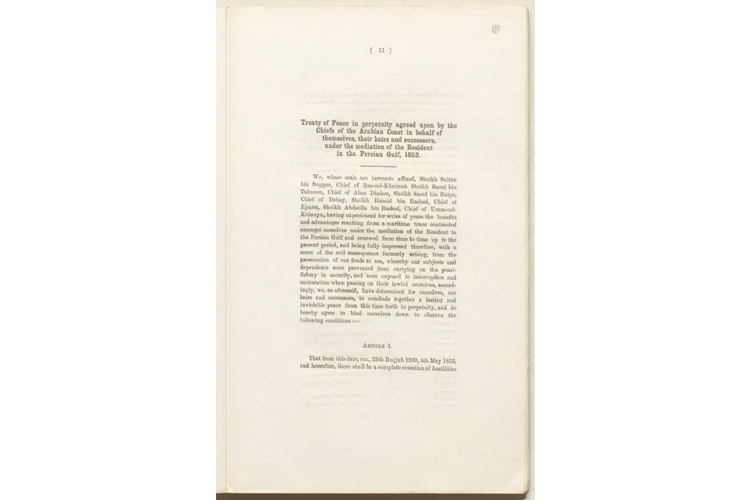
The Perpetual Maritime Truce Treaty of 1853. © Qatar National Library
The destruction and occupation of Ras Al Khaimah was a crushing military defeat for the Qawasim. From that moment on, the British imposed a series of treaties on the rulers of what would become the Trucial States, beginning with the General Peace Treaty of 1820. The signatories were not only the sheikhs of Ras Al Khaimah, but the rulers of Abu Dhabi, Ajman, Sharjah and Umm al-Quwain, too, followed by Bahrain in February 1820. The British created the post of Political Agent for the Lower Gulf to enforce the treaty, which was followed by a number of other agreements, including the Maritime Truce of 1835 and the Perpetual Maritime Truce of 1853. The latter saw the rulers of each state formally surrender their right to wage war at sea.
In total, British involvement in the Arabian Gulf would cover a period of almost 400 years. From the first expeditions of the English East India Company, to the country’s imperial heyday in the nineteenth century and its withdrawal from the Trucial States in 1971, Britain would dominate the region like no previous empire before it. Initially driven by the desire to develop trade, from 1820 onwards Britain would enjoy unprecedented commercial and political supremacy, dramatically impacting Ras Al Khaimah and the lives of its inhabitants.
REFERENCES
Al-Otabi, Mubarak: The Qawasim and British Control of the Arabian Gulf (1989). Read More
Al-Qasimi, Sultan bin Muhammad: Power Struggles and Trade in the Gulf 1620-1820 (1999). Read More
Al-Qasimi, Sultan bin Muhammad: The Myth of Arab Piracy in the Gulf (1986). Read More
Buckingham, James Silk: Travels in Assyria, Media, and Persia (1829). Read More
Carter, Robert: Sea of Pearls (2012). Read More
Costa, João: Portuguese Heritage in the United Arab Emirates Then And Now (2017). Read More
Farinha, António Dias: “Arabs and Portuguese in the area of the Emirates and the Arabian Gulf (XVI-XVIII Centuries)” in New Perspectives On Recording UAE History (Abu Dhabi: National Center for Documentation & Research, 2009).
Floor, Willem: First Contacts between the Netherlands and Masqat or A Report on the Discovery of the Coast of Oman in 1666: Translation and Introduction (1982). Read More
Willem Floor, “Omani-Portuguese Maritime Activities (1500–1650 CE),” in Oman, A Maritime History, ed. Abdulrahman al-Salimi and Eric Staples (Hildesheim: Georg Olms Verlag, 2017), pp. 15-26. Read More
Lorimer, John Gordon: Gazetteer of the Persian Gulf, Oman and Central Arabia (1908).Read More
Salman, Mohammed Hameed: Aspects of Portuguese Rule in the Arabian Gulf, 1521–1622 (2004). Read More
Slot, BJ: The Arabs of the Gulf, 1602-1784 (1995). Read More
Warden, Francis: Brief Notes Relative to the Province of Oman (1819).